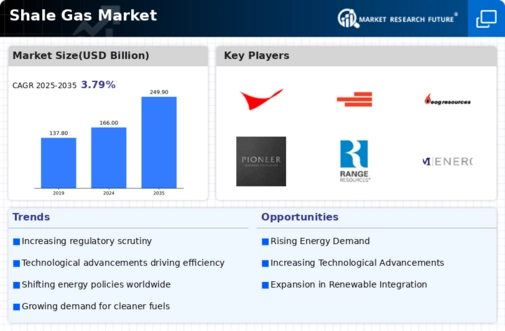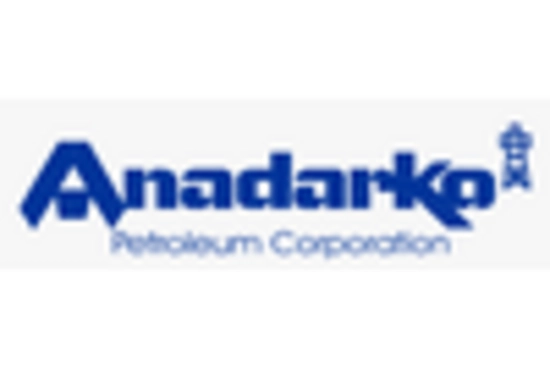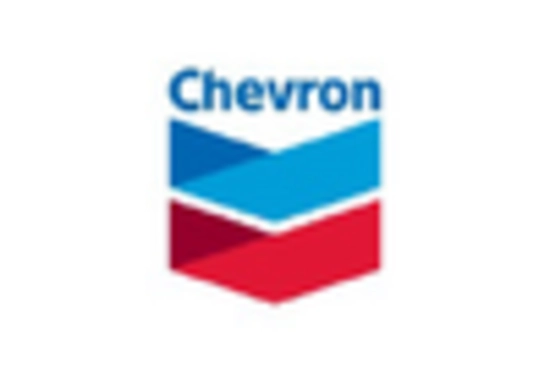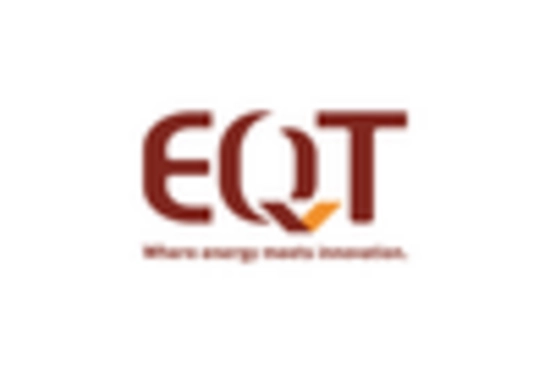-
EXECUTIVE SUMMARY
-
Market Overview
-
Key Findings
-
Market Segmentation
-
Competitive Landscape
-
Challenges and Opportunities
-
Future Outlook
-
\r\n
-
MARKET INTRODUCTION
-
Definition
-
Scope of the study
- Research Objective
- Assumption
- Limitations
-
RESEARCH METHODOLOGY
-
Overview
-
Data Mining
-
Secondary Research
-
Primary Research
- Primary Interviews and Information Gathering Process
- Breakdown of Primary Respondents
-
Forecasting Model
-
Market Size Estimation
- Bottom-Up Approach
- Top-Down Approach
-
Data Triangulation
-
Validation
-
\r\n
-
MARKET DYNAMICS
-
Overview
-
Drivers
-
Restraints
-
Opportunities
-
MARKET FACTOR ANALYSIS
-
Value chain Analysis
-
Porter's Five Forces Analysis
- Bargaining Power of Suppliers
- Bargaining Power of Buyers
- Threat of New Entrants
- Threat of Substitutes
- Intensity of Rivalry
-
COVID-19 Impact Analysis
- Market Impact Analysis
- Regional Impact
- Opportunity and Threat Analysis
-
\r\n
-
SHALE GAS MARKET, BY APPLICATION (USD BILLION)
-
Power Generation
-
Heating
-
Chemical Feedstock
-
Transportation
-
Industrial Processes
-
SHALE GAS MARKET, BY END USE (USD BILLION)
-
Residential
-
Commercial
-
Industrial
-
Utilities
-
SHALE GAS MARKET, BY METHOD OF EXTRACTION (USD BILLION)
-
Hydraulic Fracturing
-
Horizontal Drilling
-
Vertical Drilling
-
Combination Techniques
-
SHALE GAS MARKET, BY MARKET PLAYER TYPE (USD BILLION)
-
Independent Producers
-
Major Oil and Gas Companies
-
Service Providers
-
Government Entities
-
SHALE GAS MARKET, BY REGIONAL (USD BILLION)
-
North America
- US
- Canada
-
Europe
- Germany
- UK
- France
- Russia
- Italy
- Spain
- Rest of Europe
-
APAC
- China
- India
- Japan
- South Korea
- Malaysia
- Thailand
- Indonesia
- Rest of APAC
-
South America
- Brazil
- Mexico
- Argentina
- Rest of South America
-
MEA
- GCC Countries
- South Africa
- Rest of MEA
-
\r\n
-
COMPETITIVE LANDSCAPE
-
Overview
-
Competitive Analysis
-
Market share Analysis
-
Major Growth Strategy in the Shale Gas Market
-
Competitive Benchmarking
-
Leading Players in Terms of Number of Developments in the Shale Gas Market
-
Key developments and growth strategies
- New Product Launch/Service Deployment
- Merger & Acquisitions
- Joint Ventures
-
Major Players Financial Matrix
- Sales and Operating Income
- Major Players R&D Expenditure. 2023
-
COMPANY PROFILES
-
ConocoPhillips
- Financial Overview
- Products Offered
- Key Developments
- SWOT Analysis
- Key Strategies
-
Devon Energy
- Financial Overview
- Products Offered
- Key Developments
- SWOT Analysis
- Key Strategies
-
EOG Resources
- Financial Overview
- Products Offered
- Key Developments
- SWOT Analysis
- Key Strategies
-
Pioneer Natural Resources
- Financial Overview
- Products Offered
- Key Developments
- SWOT Analysis
- Key Strategies
-
Range Resources
- Financial Overview
- Products Offered
- Key Developments
- SWOT Analysis
- Key Strategies
-
National Fuel Gas Company
- Financial Overview
- Products Offered
- Key Developments
- SWOT Analysis
- Key Strategies
-
SM Energy
- Financial Overview
- Products Offered
- Key Developments
- SWOT Analysis
- Key Strategies
-
Cabot Oil & Gas
- Financial Overview
- Products Offered
- Key Developments
- SWOT Analysis
- Key Strategies
-
Anadarko Petroleum
- Financial Overview
- Products Offered
- Key Developments
- SWOT Analysis
- Key Strategies
-
Southwestern Energy
- Financial Overview
- Products Offered
- Key Developments
- SWOT Analysis
- Key Strategies
-
Exxon Mobil
- Financial Overview
- Products Offered
- Key Developments
- SWOT Analysis
- Key Strategies
-
Encana Corporation
- Financial Overview
- Products Offered
- Key Developments
- SWOT Analysis
- Key Strategies
-
Chesapeake Energy
- Financial Overview
- Products Offered
- Key Developments
- SWOT Analysis
- Key Strategies
-
Marathon Oil
- Financial Overview
- Products Offered
- Key Developments
- SWOT Analysis
- Key Strategies
-
APPENDIX
-
References
-
Related Reports
-
LIST OF TABLES
-
\r\n
-
LIST OF ASSUMPTIONS
-
NORTH AMERICA SHALE GAS MARKET SIZE ESTIMATES & FORECAST, BY APPLICATION, 2019-2035 (USD BILLIONS)
-
NORTH AMERICA SHALE GAS MARKET SIZE ESTIMATES & FORECAST, BY END USE, 2019-2035 (USD BILLIONS)
-
NORTH AMERICA SHALE GAS MARKET SIZE ESTIMATES & FORECAST, BY METHOD OF EXTRACTION, 2019-2035 (USD BILLIONS)
-
NORTH AMERICA SHALE GAS MARKET SIZE ESTIMATES & FORECAST, BY MARKET PLAYER TYPE, 2019-2035 (USD BILLIONS)
-
NORTH AMERICA SHALE GAS MARKET SIZE ESTIMATES & FORECAST, BY REGIONAL, 2019-2035 (USD BILLIONS)
-
US SHALE GAS MARKET SIZE ESTIMATES & FORECAST, BY APPLICATION, 2019-2035 (USD BILLIONS)
-
US SHALE GAS MARKET SIZE ESTIMATES & FORECAST, BY END USE, 2019-2035 (USD BILLIONS)
-
US SHALE GAS MARKET SIZE ESTIMATES & FORECAST, BY METHOD OF EXTRACTION, 2019-2035 (USD BILLIONS)
-
US SHALE GAS MARKET SIZE ESTIMATES & FORECAST, BY MARKET PLAYER TYPE, 2019-2035 (USD BILLIONS)
-
US SHALE GAS MARKET SIZE ESTIMATES & FORECAST, BY REGIONAL, 2019-2035 (USD BILLIONS)
-
CANADA SHALE GAS MARKET SIZE ESTIMATES & FORECAST, BY APPLICATION, 2019-2035 (USD BILLIONS)
-
CANADA SHALE GAS MARKET SIZE ESTIMATES & FORECAST, BY END USE, 2019-2035 (USD BILLIONS)
-
CANADA SHALE GAS MARKET SIZE ESTIMATES & FORECAST, BY METHOD OF EXTRACTION, 2019-2035 (USD BILLIONS)
-
CANADA SHALE GAS MARKET SIZE ESTIMATES & FORECAST, BY MARKET PLAYER TYPE, 2019-2035 (USD BILLIONS)
-
CANADA SHALE GAS MARKET SIZE ESTIMATES & FORECAST, BY REGIONAL, 2019-2035 (USD BILLIONS)
-
EUROPE SHALE GAS MARKET SIZE ESTIMATES & FORECAST, BY APPLICATION, 2019-2035 (USD BILLIONS)
-
EUROPE SHALE GAS MARKET SIZE ESTIMATES & FORECAST, BY END USE, 2019-2035 (USD BILLIONS)
-
EUROPE SHALE GAS MARKET SIZE ESTIMATES & FORECAST, BY METHOD OF EXTRACTION, 2019-2035 (USD BILLIONS)
-
EUROPE SHALE GAS MARKET SIZE ESTIMATES & FORECAST, BY MARKET PLAYER TYPE, 2019-2035 (USD BILLIONS)
-
EUROPE SHALE GAS MARKET SIZE ESTIMATES & FORECAST, BY REGIONAL, 2019-2035 (USD BILLIONS)
-
GERMANY SHALE GAS MARKET SIZE ESTIMATES & FORECAST, BY APPLICATION, 2019-2035 (USD BILLIONS)
-
GERMANY SHALE GAS MARKET SIZE ESTIMATES & FORECAST, BY END USE, 2019-2035 (USD BILLIONS)
-
GERMANY SHALE GAS MARKET SIZE ESTIMATES & FORECAST, BY METHOD OF EXTRACTION, 2019-2035 (USD BILLIONS)
-
GERMANY SHALE GAS MARKET SIZE ESTIMATES & FORECAST, BY MARKET PLAYER TYPE, 2019-2035 (USD BILLIONS)
-
GERMANY SHALE GAS MARKET SIZE ESTIMATES & FORECAST, BY REGIONAL, 2019-2035 (USD BILLIONS)
-
UK SHALE GAS MARKET SIZE ESTIMATES & FORECAST, BY APPLICATION, 2019-2035 (USD BILLIONS)
-
UK SHALE GAS MARKET SIZE ESTIMATES & FORECAST, BY END USE, 2019-2035 (USD BILLIONS)
-
UK SHALE GAS MARKET SIZE ESTIMATES & FORECAST, BY METHOD OF EXTRACTION, 2019-2035 (USD BILLIONS)
-
UK SHALE GAS MARKET SIZE ESTIMATES & FORECAST, BY MARKET PLAYER TYPE, 2019-2035 (USD BILLIONS)
-
UK SHALE GAS MARKET SIZE ESTIMATES & FORECAST, BY REGIONAL, 2019-2035 (USD BILLIONS)
-
FRANCE SHALE GAS MARKET SIZE ESTIMATES & FORECAST, BY APPLICATION, 2019-2035 (USD BILLIONS)
-
FRANCE SHALE GAS MARKET SIZE ESTIMATES & FORECAST, BY END USE, 2019-2035 (USD BILLIONS)
-
FRANCE SHALE GAS MARKET SIZE ESTIMATES & FORECAST, BY METHOD OF EXTRACTION, 2019-2035 (USD BILLIONS)
-
FRANCE SHALE GAS MARKET SIZE ESTIMATES & FORECAST, BY MARKET PLAYER TYPE, 2019-2035 (USD BILLIONS)
-
FRANCE SHALE GAS MARKET SIZE ESTIMATES & FORECAST, BY REGIONAL, 2019-2035 (USD BILLIONS)
-
RUSSIA SHALE GAS MARKET SIZE ESTIMATES & FORECAST, BY APPLICATION, 2019-2035 (USD BILLIONS)
-
RUSSIA SHALE GAS MARKET SIZE ESTIMATES & FORECAST, BY END USE, 2019-2035 (USD BILLIONS)
-
RUSSIA SHALE GAS MARKET SIZE ESTIMATES & FORECAST, BY METHOD OF EXTRACTION, 2019-2035 (USD BILLIONS)
-
RUSSIA SHALE GAS MARKET SIZE ESTIMATES & FORECAST, BY MARKET PLAYER TYPE, 2019-2035 (USD BILLIONS)
-
RUSSIA SHALE GAS MARKET SIZE ESTIMATES & FORECAST, BY REGIONAL, 2019-2035 (USD BILLIONS)
-
ITALY SHALE GAS MARKET SIZE ESTIMATES & FORECAST, BY APPLICATION, 2019-2035 (USD BILLIONS)
-
ITALY SHALE GAS MARKET SIZE ESTIMATES & FORECAST, BY END USE, 2019-2035 (USD BILLIONS)
-
ITALY SHALE GAS MARKET SIZE ESTIMATES & FORECAST, BY METHOD OF EXTRACTION, 2019-2035 (USD BILLIONS)
-
ITALY SHALE GAS MARKET SIZE ESTIMATES & FORECAST, BY MARKET PLAYER TYPE, 2019-2035 (USD BILLIONS)
-
ITALY SHALE GAS MARKET SIZE ESTIMATES & FORECAST, BY REGIONAL, 2019-2035 (USD BILLIONS)
-
SPAIN SHALE GAS MARKET SIZE ESTIMATES & FORECAST, BY APPLICATION, 2019-2035 (USD BILLIONS)
-
SPAIN SHALE GAS MARKET SIZE ESTIMATES & FORECAST, BY END USE, 2019-2035 (USD BILLIONS)
-
SPAIN SHALE GAS MARKET SIZE ESTIMATES & FORECAST, BY METHOD OF EXTRACTION, 2019-2035 (USD BILLIONS)
-
SPAIN SHALE GAS MARKET SIZE ESTIMATES & FORECAST, BY MARKET PLAYER TYPE, 2019-2035 (USD BILLIONS)
-
SPAIN SHALE GAS MARKET SIZE ESTIMATES & FORECAST, BY REGIONAL, 2019-2035 (USD BILLIONS)
-
REST OF EUROPE SHALE GAS MARKET SIZE ESTIMATES & FORECAST, BY APPLICATION, 2019-2035 (USD BILLIONS)
-
REST OF EUROPE SHALE GAS MARKET SIZE ESTIMATES & FORECAST, BY END USE, 2019-2035 (USD BILLIONS)
-
REST OF EUROPE SHALE GAS MARKET SIZE ESTIMATES & FORECAST, BY METHOD OF EXTRACTION, 2019-2035 (USD BILLIONS)
-
REST OF EUROPE SHALE GAS MARKET SIZE ESTIMATES & FORECAST, BY MARKET PLAYER TYPE, 2019-2035 (USD BILLIONS)
-
REST OF EUROPE SHALE GAS MARKET SIZE ESTIMATES & FORECAST, BY REGIONAL, 2019-2035 (USD BILLIONS)
-
APAC SHALE GAS MARKET SIZE ESTIMATES & FORECAST, BY APPLICATION, 2019-2035 (USD BILLIONS)
-
APAC SHALE GAS MARKET SIZE ESTIMATES & FORECAST, BY END USE, 2019-2035 (USD BILLIONS)
-
APAC SHALE GAS MARKET SIZE ESTIMATES & FORECAST, BY METHOD OF EXTRACTION, 2019-2035 (USD BILLIONS)
-
APAC SHALE GAS MARKET SIZE ESTIMATES & FORECAST, BY MARKET PLAYER TYPE, 2019-2035 (USD BILLIONS)
-
APAC SHALE GAS MARKET SIZE ESTIMATES & FORECAST, BY REGIONAL, 2019-2035 (USD BILLIONS)
-
CHINA SHALE GAS MARKET SIZE ESTIMATES & FORECAST, BY APPLICATION, 2019-2035 (USD BILLIONS)
-
CHINA SHALE GAS MARKET SIZE ESTIMATES & FORECAST, BY END USE, 2019-2035 (USD BILLIONS)
-
CHINA SHALE GAS MARKET SIZE ESTIMATES & FORECAST, BY METHOD OF EXTRACTION, 2019-2035 (USD BILLIONS)
-
CHINA SHALE GAS MARKET SIZE ESTIMATES & FORECAST, BY MARKET PLAYER TYPE, 2019-2035 (USD BILLIONS)
-
CHINA SHALE GAS MARKET SIZE ESTIMATES & FORECAST, BY REGIONAL, 2019-2035 (USD BILLIONS)
-
INDIA SHALE GAS MARKET SIZE ESTIMATES & FORECAST, BY APPLICATION, 2019-2035 (USD BILLIONS)
-
INDIA SHALE GAS MARKET SIZE ESTIMATES & FORECAST, BY END USE, 2019-2035 (USD BILLIONS)
-
INDIA SHALE GAS MARKET SIZE ESTIMATES & FORECAST, BY METHOD OF EXTRACTION, 2019-2035 (USD BILLIONS)
-
INDIA SHALE GAS MARKET SIZE ESTIMATES & FORECAST, BY MARKET PLAYER TYPE, 2019-2035 (USD BILLIONS)
-
INDIA SHALE GAS MARKET SIZE ESTIMATES & FORECAST, BY REGIONAL, 2019-2035 (USD BILLIONS)
-
JAPAN SHALE GAS MARKET SIZE ESTIMATES & FORECAST, BY APPLICATION, 2019-2035 (USD BILLIONS)
-
JAPAN SHALE GAS MARKET SIZE ESTIMATES & FORECAST, BY END USE, 2019-2035 (USD BILLIONS)
-
JAPAN SHALE GAS MARKET SIZE ESTIMATES & FORECAST, BY METHOD OF EXTRACTION, 2019-2035 (USD BILLIONS)
-
JAPAN SHALE GAS MARKET SIZE ESTIMATES & FORECAST, BY MARKET PLAYER TYPE, 2019-2035 (USD BILLIONS)
-
JAPAN SHALE GAS MARKET SIZE ESTIMATES & FORECAST, BY REGIONAL, 2019-2035 (USD BILLIONS)
-
SOUTH KOREA SHALE GAS MARKET SIZE ESTIMATES & FORECAST, BY APPLICATION, 2019-2035 (USD BILLIONS)
-
SOUTH KOREA SHALE GAS MARKET SIZE ESTIMATES & FORECAST, BY END USE, 2019-2035 (USD BILLIONS)
-
SOUTH KOREA SHALE GAS MARKET SIZE ESTIMATES & FORECAST, BY METHOD OF EXTRACTION, 2019-2035 (USD BILLIONS)
-
SOUTH KOREA SHALE GAS MARKET SIZE ESTIMATES & FORECAST, BY MARKET PLAYER TYPE, 2019-2035 (USD BILLIONS)
-
SOUTH KOREA SHALE GAS MARKET SIZE ESTIMATES & FORECAST, BY REGIONAL, 2019-2035 (USD BILLIONS)
-
MALAYSIA SHALE GAS MARKET SIZE ESTIMATES & FORECAST, BY APPLICATION, 2019-2035 (USD BILLIONS)
-
MALAYSIA SHALE GAS MARKET SIZE ESTIMATES & FORECAST, BY END USE, 2019-2035 (USD BILLIONS)
-
MALAYSIA SHALE GAS MARKET SIZE ESTIMATES & FORECAST, BY METHOD OF EXTRACTION, 2019-2035 (USD BILLIONS)
-
MALAYSIA SHALE GAS MARKET SIZE ESTIMATES & FORECAST, BY MARKET PLAYER TYPE, 2019-2035 (USD BILLIONS)
-
MALAYSIA SHALE GAS MARKET SIZE ESTIMATES & FORECAST, BY REGIONAL, 2019-2035 (USD BILLIONS)
-
THAILAND SHALE GAS MARKET SIZE ESTIMATES & FORECAST, BY APPLICATION, 2019-2035 (USD BILLIONS)
-
THAILAND SHALE GAS MARKET SIZE ESTIMATES & FORECAST, BY END USE, 2019-2035 (USD BILLIONS)
-
THAILAND SHALE GAS MARKET SIZE ESTIMATES & FORECAST, BY METHOD OF EXTRACTION, 2019-2035 (USD BILLIONS)
-
THAILAND SHALE GAS MARKET SIZE ESTIMATES & FORECAST, BY MARKET PLAYER TYPE, 2019-2035 (USD BILLIONS)
-
THAILAND SHALE GAS MARKET SIZE ESTIMATES & FORECAST, BY REGIONAL, 2019-2035 (USD BILLIONS)
-
INDONESIA SHALE GAS MARKET SIZE ESTIMATES & FORECAST, BY APPLICATION, 2019-2035 (USD BILLIONS)
-
INDONESIA SHALE GAS MARKET SIZE ESTIMATES & FORECAST, BY END USE, 2019-2035 (USD BILLIONS)
-
INDONESIA SHALE GAS MARKET SIZE ESTIMATES & FORECAST, BY METHOD OF EXTRACTION, 2019-2035 (USD BILLIONS)
-
INDONESIA SHALE GAS MARKET SIZE ESTIMATES & FORECAST, BY MARKET PLAYER TYPE, 2019-2035 (USD BILLIONS)
-
INDONESIA SHALE GAS MARKET SIZE ESTIMATES & FORECAST, BY REGIONAL, 2019-2035 (USD BILLIONS)
-
REST OF APAC SHALE GAS MARKET SIZE ESTIMATES & FORECAST, BY APPLICATION, 2019-2035 (USD BILLIONS)
-
REST OF APAC SHALE GAS MARKET SIZE ESTIMATES & FORECAST, BY END USE, 2019-2035 (USD BILLIONS)
-
REST OF APAC SHALE GAS MARKET SIZE ESTIMATES & FORECAST, BY METHOD OF EXTRACTION, 2019-2035 (USD BILLIONS)
-
REST OF APAC SHALE GAS MARKET SIZE ESTIMATES & FORECAST, BY MARKET PLAYER TYPE, 2019-2035 (USD BILLIONS)
-
REST OF APAC SHALE GAS MARKET SIZE ESTIMATES & FORECAST, BY REGIONAL, 2019-2035 (USD BILLIONS)
-
SOUTH AMERICA SHALE GAS MARKET SIZE ESTIMATES & FORECAST, BY APPLICATION, 2019-2035 (USD BILLIONS)
-
SOUTH AMERICA SHALE GAS MARKET SIZE ESTIMATES & FORECAST, BY END USE, 2019-2035 (USD BILLIONS)
-
SOUTH AMERICA SHALE GAS MARKET SIZE ESTIMATES & FORECAST, BY METHOD OF EXTRACTION, 2019-2035 (USD BILLIONS)
-
SOUTH AMERICA SHALE GAS MARKET SIZE ESTIMATES & FORECAST, BY MARKET PLAYER TYPE, 2019-2035 (USD BILLIONS)
-
SOUTH AMERICA SHALE GAS MARKET SIZE ESTIMATES & FORECAST, BY REGIONAL, 2019-2035 (USD BILLIONS)
-
BRAZIL SHALE GAS MARKET SIZE ESTIMATES & FORECAST, BY APPLICATION, 2019-2035 (USD BILLIONS)
-
BRAZIL SHALE GAS MARKET SIZE ESTIMATES & FORECAST, BY END USE, 2019-2035 (USD BILLIONS)
-
BRAZIL SHALE GAS MARKET SIZE ESTIMATES & FORECAST, BY METHOD OF EXTRACTION, 2019-2035 (USD BILLIONS)
-
BRAZIL SHALE GAS MARKET SIZE ESTIMATES & FORECAST, BY MARKET PLAYER TYPE, 2019-2035 (USD BILLIONS)
-
BRAZIL SHALE GAS MARKET SIZE ESTIMATES & FORECAST, BY REGIONAL, 2019-2035 (USD BILLIONS)
-
MEXICO SHALE GAS MARKET SIZE ESTIMATES & FORECAST, BY APPLICATION, 2019-2035 (USD BILLIONS)
-
MEXICO SHALE GAS MARKET SIZE ESTIMATES & FORECAST, BY END USE, 2019-2035 (USD BILLIONS)
-
MEXICO SHALE GAS MARKET SIZE ESTIMATES & FORECAST, BY METHOD OF EXTRACTION, 2019-2035 (USD BILLIONS)
-
MEXICO SHALE GAS MARKET SIZE ESTIMATES & FORECAST, BY MARKET PLAYER TYPE, 2019-2035 (USD BILLIONS)
-
MEXICO SHALE GAS MARKET SIZE ESTIMATES & FORECAST, BY REGIONAL, 2019-2035 (USD BILLIONS)
-
ARGENTINA SHALE GAS MARKET SIZE ESTIMATES & FORECAST, BY APPLICATION, 2019-2035 (USD BILLIONS)
-
ARGENTINA SHALE GAS MARKET SIZE ESTIMATES & FORECAST, BY END USE, 2019-2035 (USD BILLIONS)
-
ARGENTINA SHALE GAS MARKET SIZE ESTIMATES & FORECAST, BY METHOD OF EXTRACTION, 2019-2035 (USD BILLIONS)
-
ARGENTINA SHALE GAS MARKET SIZE ESTIMATES & FORECAST, BY MARKET PLAYER TYPE, 2019-2035 (USD BILLIONS)
-
ARGENTINA SHALE GAS MARKET SIZE ESTIMATES & FORECAST, BY REGIONAL, 2019-2035 (USD BILLIONS)
-
REST OF SOUTH AMERICA SHALE GAS MARKET SIZE ESTIMATES & FORECAST, BY APPLICATION, 2019-2035 (USD BILLIONS)
-
REST OF SOUTH AMERICA SHALE GAS MARKET SIZE ESTIMATES & FORECAST, BY END USE, 2019-2035 (USD BILLIONS)
-
REST OF SOUTH AMERICA SHALE GAS MARKET SIZE ESTIMATES & FORECAST, BY METHOD OF EXTRACTION, 2019-2035 (USD BILLIONS)
-
REST OF SOUTH AMERICA SHALE GAS MARKET SIZE ESTIMATES & FORECAST, BY MARKET PLAYER TYPE, 2019-2035 (USD BILLIONS)
-
REST OF SOUTH AMERICA SHALE GAS MARKET SIZE ESTIMATES & FORECAST, BY REGIONAL, 2019-2035 (USD BILLIONS)
-
MEA SHALE GAS MARKET SIZE ESTIMATES & FORECAST, BY APPLICATION, 2019-2035 (USD BILLIONS)
-
MEA SHALE GAS MARKET SIZE ESTIMATES & FORECAST, BY END USE, 2019-2035 (USD BILLIONS)
-
MEA SHALE GAS MARKET SIZE ESTIMATES & FORECAST, BY METHOD OF EXTRACTION, 2019-2035 (USD BILLIONS)
-
MEA SHALE GAS MARKET SIZE ESTIMATES & FORECAST, BY MARKET PLAYER TYPE, 2019-2035 (USD BILLIONS)
-
MEA SHALE GAS MARKET SIZE ESTIMATES & FORECAST, BY REGIONAL, 2019-2035 (USD BILLIONS)
-
GCC COUNTRIES SHALE GAS MARKET SIZE ESTIMATES & FORECAST, BY APPLICATION, 2019-2035 (USD BILLIONS)
-
GCC COUNTRIES SHALE GAS MARKET SIZE ESTIMATES & FORECAST, BY END USE, 2019-2035 (USD BILLIONS)
-
GCC COUNTRIES SHALE GAS MARKET SIZE ESTIMATES & FORECAST, BY METHOD OF EXTRACTION, 2019-2035 (USD BILLIONS)
-
GCC COUNTRIES SHALE GAS MARKET SIZE ESTIMATES & FORECAST, BY MARKET PLAYER TYPE, 2019-2035 (USD BILLIONS)
-
GCC COUNTRIES SHALE GAS MARKET SIZE ESTIMATES & FORECAST, BY REGIONAL, 2019-2035 (USD BILLIONS)
-
SOUTH AFRICA SHALE GAS MARKET SIZE ESTIMATES & FORECAST, BY APPLICATION, 2019-2035 (USD BILLIONS)
-
SOUTH AFRICA SHALE GAS MARKET SIZE ESTIMATES & FORECAST, BY END USE, 2019-2035 (USD BILLIONS)
-
SOUTH AFRICA SHALE GAS MARKET SIZE ESTIMATES & FORECAST, BY METHOD OF EXTRACTION, 2019-2035 (USD BILLIONS)
-
SOUTH AFRICA SHALE GAS MARKET SIZE ESTIMATES & FORECAST, BY MARKET PLAYER TYPE, 2019-2035 (USD BILLIONS)
-
SOUTH AFRICA SHALE GAS MARKET SIZE ESTIMATES & FORECAST, BY REGIONAL, 2019-2035 (USD BILLIONS)
-
REST OF MEA SHALE GAS MARKET SIZE ESTIMATES & FORECAST, BY APPLICATION, 2019-2035 (USD BILLIONS)
-
REST OF MEA SHALE GAS MARKET SIZE ESTIMATES & FORECAST, BY END USE, 2019-2035 (USD BILLIONS)
-
REST OF MEA SHALE GAS MARKET SIZE ESTIMATES & FORECAST, BY METHOD OF EXTRACTION, 2019-2035 (USD BILLIONS)
-
REST OF MEA SHALE GAS MARKET SIZE ESTIMATES & FORECAST, BY MARKET PLAYER TYPE, 2019-2035 (USD BILLIONS)
-
REST OF MEA SHALE GAS MARKET SIZE ESTIMATES & FORECAST, BY REGIONAL, 2019-2035 (USD BILLIONS)
-
PRODUCT LAUNCH/PRODUCT DEVELOPMENT/APPROVAL
-
ACQUISITION/PARTNERSHIP
-
\r\n
-
\r\n
-
\r\n
-
\r\n
-
\r\n
-
\r\n
-
\r\n
-
\r\n
-
\r\n
-
\r\n
-
\r\n
-
\r\n
-
\r\n
-
\r\n
-
\r\n
-
LIST OF FIGURES
-
\r\n
-
MARKET SYNOPSIS
-
NORTH AMERICA SHALE GAS MARKET ANALYSIS
-
US SHALE GAS MARKET ANALYSIS BY APPLICATION
-
US SHALE GAS MARKET ANALYSIS BY END USE
-
US SHALE GAS MARKET ANALYSIS BY METHOD OF EXTRACTION
-
US SHALE GAS MARKET ANALYSIS BY MARKET PLAYER TYPE
-
US SHALE GAS MARKET ANALYSIS BY REGIONAL
-
CANADA SHALE GAS MARKET ANALYSIS BY APPLICATION
-
CANADA SHALE GAS MARKET ANALYSIS BY END USE
-
CANADA SHALE GAS MARKET ANALYSIS BY METHOD OF EXTRACTION
-
CANADA SHALE GAS MARKET ANALYSIS BY MARKET PLAYER TYPE
-
CANADA SHALE GAS MARKET ANALYSIS BY REGIONAL
-
EUROPE SHALE GAS MARKET ANALYSIS
-
GERMANY SHALE GAS MARKET ANALYSIS BY APPLICATION
-
GERMANY SHALE GAS MARKET ANALYSIS BY END USE
-
GERMANY SHALE GAS MARKET ANALYSIS BY METHOD OF EXTRACTION
-
GERMANY SHALE GAS MARKET ANALYSIS BY MARKET PLAYER TYPE
-
GERMANY SHALE GAS MARKET ANALYSIS BY REGIONAL
-
UK SHALE GAS MARKET ANALYSIS BY APPLICATION
-
UK SHALE GAS MARKET ANALYSIS BY END USE
-
UK SHALE GAS MARKET ANALYSIS BY METHOD OF EXTRACTION
-
UK SHALE GAS MARKET ANALYSIS BY MARKET PLAYER TYPE
-
UK SHALE GAS MARKET ANALYSIS BY REGIONAL
-
FRANCE SHALE GAS MARKET ANALYSIS BY APPLICATION
-
FRANCE SHALE GAS MARKET ANALYSIS BY END USE
-
FRANCE SHALE GAS MARKET ANALYSIS BY METHOD OF EXTRACTION
-
FRANCE SHALE GAS MARKET ANALYSIS BY MARKET PLAYER TYPE
-
FRANCE SHALE GAS MARKET ANALYSIS BY REGIONAL
-
RUSSIA SHALE GAS MARKET ANALYSIS BY APPLICATION
-
RUSSIA SHALE GAS MARKET ANALYSIS BY END USE
-
RUSSIA SHALE GAS MARKET ANALYSIS BY METHOD OF EXTRACTION
-
RUSSIA SHALE GAS MARKET ANALYSIS BY MARKET PLAYER TYPE
-
RUSSIA SHALE GAS MARKET ANALYSIS BY REGIONAL
-
ITALY SHALE GAS MARKET ANALYSIS BY APPLICATION
-
ITALY SHALE GAS MARKET ANALYSIS BY END USE
-
ITALY SHALE GAS MARKET ANALYSIS BY METHOD OF EXTRACTION
-
ITALY SHALE GAS MARKET ANALYSIS BY MARKET PLAYER TYPE
-
ITALY SHALE GAS MARKET ANALYSIS BY REGIONAL
-
SPAIN SHALE GAS MARKET ANALYSIS BY APPLICATION
-
SPAIN SHALE GAS MARKET ANALYSIS BY END USE
-
SPAIN SHALE GAS MARKET ANALYSIS BY METHOD OF EXTRACTION
-
SPAIN SHALE GAS MARKET ANALYSIS BY MARKET PLAYER TYPE
-
SPAIN SHALE GAS MARKET ANALYSIS BY REGIONAL
-
REST OF EUROPE SHALE GAS MARKET ANALYSIS BY APPLICATION
-
REST OF EUROPE SHALE GAS MARKET ANALYSIS BY END USE
-
REST OF EUROPE SHALE GAS MARKET ANALYSIS BY METHOD OF EXTRACTION
-
REST OF EUROPE SHALE GAS MARKET ANALYSIS BY MARKET PLAYER TYPE
-
REST OF EUROPE SHALE GAS MARKET ANALYSIS BY REGIONAL
-
APAC SHALE GAS MARKET ANALYSIS
-
CHINA SHALE GAS MARKET ANALYSIS BY APPLICATION
-
CHINA SHALE GAS MARKET ANALYSIS BY END USE
-
CHINA SHALE GAS MARKET ANALYSIS BY METHOD OF EXTRACTION
-
CHINA SHALE GAS MARKET ANALYSIS BY MARKET PLAYER TYPE
-
CHINA SHALE GAS MARKET ANALYSIS BY REGIONAL
-
INDIA SHALE GAS MARKET ANALYSIS BY APPLICATION
-
INDIA SHALE GAS MARKET ANALYSIS BY END USE
-
INDIA SHALE GAS MARKET ANALYSIS BY METHOD OF EXTRACTION
-
INDIA SHALE GAS MARKET ANALYSIS BY MARKET PLAYER TYPE
-
INDIA SHALE GAS MARKET ANALYSIS BY REGIONAL
-
JAPAN SHALE GAS MARKET ANALYSIS BY APPLICATION
-
JAPAN SHALE GAS MARKET ANALYSIS BY END USE
-
JAPAN SHALE GAS MARKET ANALYSIS BY METHOD OF EXTRACTION
-
JAPAN SHALE GAS MARKET ANALYSIS BY MARKET PLAYER TYPE
-
JAPAN SHALE GAS MARKET ANALYSIS BY REGIONAL
-
SOUTH KOREA SHALE GAS MARKET ANALYSIS BY APPLICATION
-
SOUTH KOREA SHALE GAS MARKET ANALYSIS BY END USE
-
SOUTH KOREA SHALE GAS MARKET ANALYSIS BY METHOD OF EXTRACTION
-
SOUTH KOREA SHALE GAS MARKET ANALYSIS BY MARKET PLAYER TYPE
-
SOUTH KOREA SHALE GAS MARKET ANALYSIS BY REGIONAL
-
MALAYSIA SHALE GAS MARKET ANALYSIS BY APPLICATION
-
MALAYSIA SHALE GAS MARKET ANALYSIS BY END USE
-
MALAYSIA SHALE GAS MARKET ANALYSIS BY METHOD OF EXTRACTION
-
MALAYSIA SHALE GAS MARKET ANALYSIS BY MARKET PLAYER TYPE
-
MALAYSIA SHALE GAS MARKET ANALYSIS BY REGIONAL
-
THAILAND SHALE GAS MARKET ANALYSIS BY APPLICATION
-
THAILAND SHALE GAS MARKET ANALYSIS BY END USE
-
THAILAND SHALE GAS MARKET ANALYSIS BY METHOD OF EXTRACTION
-
THAILAND SHALE GAS MARKET ANALYSIS BY MARKET PLAYER TYPE
-
THAILAND SHALE GAS MARKET ANALYSIS BY REGIONAL
-
INDONESIA SHALE GAS MARKET ANALYSIS BY APPLICATION
-
INDONESIA SHALE GAS MARKET ANALYSIS BY END USE
-
INDONESIA SHALE GAS MARKET ANALYSIS BY METHOD OF EXTRACTION
-
INDONESIA SHALE GAS MARKET ANALYSIS BY MARKET PLAYER TYPE
-
INDONESIA SHALE GAS MARKET ANALYSIS BY REGIONAL
-
REST OF APAC SHALE GAS MARKET ANALYSIS BY APPLICATION
-
REST OF APAC SHALE GAS MARKET ANALYSIS BY END USE
-
REST OF APAC SHALE GAS MARKET ANALYSIS BY METHOD OF EXTRACTION
-
REST OF APAC SHALE GAS MARKET ANALYSIS BY MARKET PLAYER TYPE
-
REST OF APAC SHALE GAS MARKET ANALYSIS BY REGIONAL
-
SOUTH AMERICA SHALE GAS MARKET ANALYSIS
-
BRAZIL SHALE GAS MARKET ANALYSIS BY APPLICATION
-
BRAZIL SHALE GAS MARKET ANALYSIS BY END USE
-
BRAZIL SHALE GAS MARKET ANALYSIS BY METHOD OF EXTRACTION
-
BRAZIL SHALE GAS MARKET ANALYSIS BY MARKET PLAYER TYPE
-
BRAZIL SHALE GAS MARKET ANALYSIS BY REGIONAL
-
MEXICO SHALE GAS MARKET ANALYSIS BY APPLICATION
-
MEXICO SHALE GAS MARKET ANALYSIS BY END USE
-
MEXICO SHALE GAS MARKET ANALYSIS BY METHOD OF EXTRACTION
-
MEXICO SHALE GAS MARKET ANALYSIS BY MARKET PLAYER TYPE
-
MEXICO SHALE GAS MARKET ANALYSIS BY REGIONAL
-
ARGENTINA SHALE GAS MARKET ANALYSIS BY APPLICATION
-
ARGENTINA SHALE GAS MARKET ANALYSIS BY END USE
-
ARGENTINA SHALE GAS MARKET ANALYSIS BY METHOD OF EXTRACTION
-
ARGENTINA SHALE GAS MARKET ANALYSIS BY MARKET PLAYER TYPE
-
ARGENTINA SHALE GAS MARKET ANALYSIS BY REGIONAL
-
REST OF SOUTH AMERICA SHALE GAS MARKET ANALYSIS BY APPLICATION
-
REST OF SOUTH AMERICA SHALE GAS MARKET ANALYSIS BY END USE
-
REST OF SOUTH AMERICA SHALE GAS MARKET ANALYSIS BY METHOD OF EXTRACTION
-
REST OF SOUTH AMERICA SHALE GAS MARKET ANALYSIS BY MARKET PLAYER TYPE
-
REST OF SOUTH AMERICA SHALE GAS MARKET ANALYSIS BY REGIONAL
-
MEA SHALE GAS MARKET ANALYSIS
-
GCC COUNTRIES SHALE GAS MARKET ANALYSIS BY APPLICATION
-
GCC COUNTRIES SHALE GAS MARKET ANALYSIS BY END USE
-
GCC COUNTRIES SHALE GAS MARKET ANALYSIS BY METHOD OF EXTRACTION
-
GCC COUNTRIES SHALE GAS MARKET ANALYSIS BY MARKET PLAYER TYPE
-
GCC COUNTRIES SHALE GAS MARKET ANALYSIS BY REGIONAL
-
SOUTH AFRICA SHALE GAS MARKET ANALYSIS BY APPLICATION
-
SOUTH AFRICA SHALE GAS MARKET ANALYSIS BY END USE
-
SOUTH AFRICA SHALE GAS MARKET ANALYSIS BY METHOD OF EXTRACTION
-
SOUTH AFRICA SHALE GAS MARKET ANALYSIS BY MARKET PLAYER TYPE
-
SOUTH AFRICA SHALE GAS MARKET ANALYSIS BY REGIONAL
-
REST OF MEA SHALE GAS MARKET ANALYSIS BY APPLICATION
-
REST OF MEA SHALE GAS MARKET ANALYSIS BY END USE
-
REST OF MEA SHALE GAS MARKET ANALYSIS BY METHOD OF EXTRACTION
-
REST OF MEA SHALE GAS MARKET ANALYSIS BY MARKET PLAYER TYPE
-
REST OF MEA SHALE GAS MARKET ANALYSIS BY REGIONAL
-
KEY BUYING CRITERIA OF SHALE GAS MARKET
-
RESEARCH PROCESS OF MRFR
-
DRO ANALYSIS OF SHALE GAS MARKET
-
DRIVERS IMPACT ANALYSIS: SHALE GAS MARKET
-
RESTRAINTS IMPACT ANALYSIS: SHALE GAS MARKET
-
SUPPLY / VALUE CHAIN: SHALE GAS MARKET
-
SHALE GAS MARKET, BY APPLICATION, 2025 (% SHARE)
-
SHALE GAS MARKET, BY APPLICATION, 2019 TO 2035 (USD Billions)
-
SHALE GAS MARKET, BY END USE, 2025 (% SHARE)
-
SHALE GAS MARKET, BY END USE, 2019 TO 2035 (USD Billions)
-
SHALE GAS MARKET, BY METHOD OF EXTRACTION, 2025 (% SHARE)
-
SHALE GAS MARKET, BY METHOD OF EXTRACTION, 2019 TO 2035 (USD Billions)
-
SHALE GAS MARKET, BY MARKET PLAYER TYPE, 2025 (% SHARE)
-
SHALE GAS MARKET, BY MARKET PLAYER TYPE, 2019 TO 2035 (USD Billions)
-
SHALE GAS MARKET, BY REGIONAL, 2025 (% SHARE)
-
SHALE GAS MARKET, BY REGIONAL, 2019 TO 2035 (USD Billions)
-
BENCHMARKING OF MAJOR COMPETITORS
-
\r\n









Leave a Comment